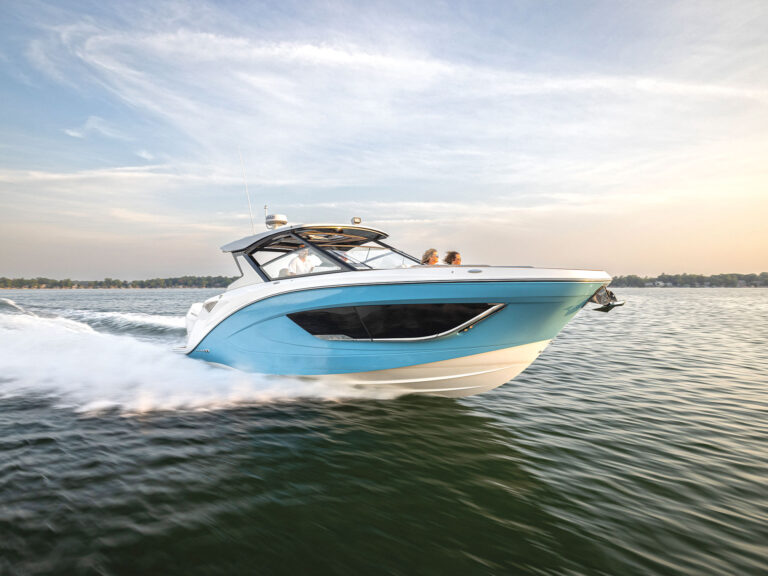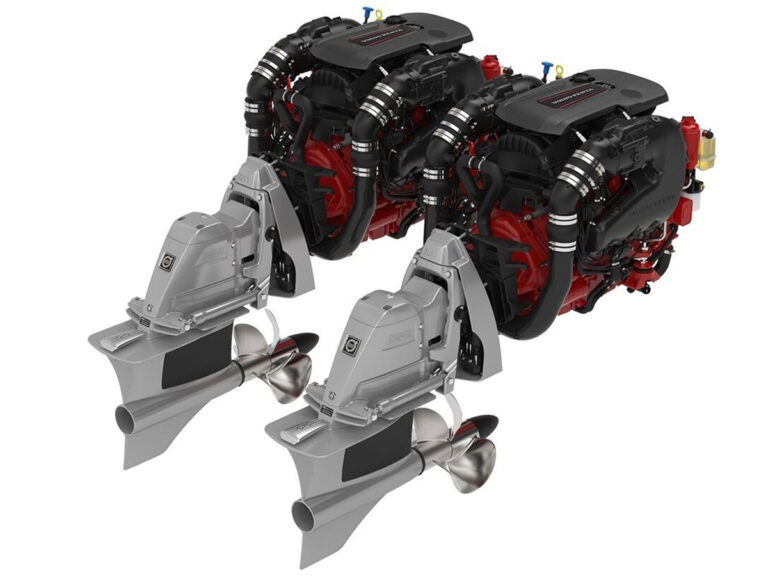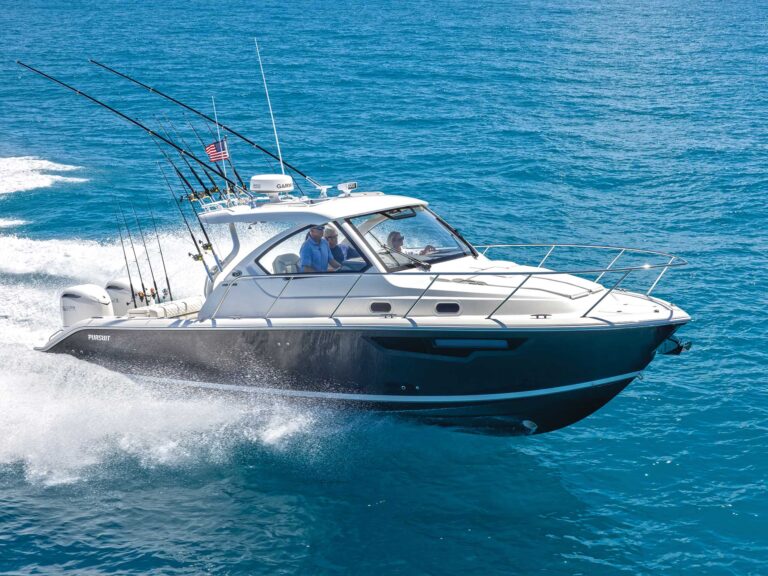Any speaker set played alone will probably sound good. But we wanted to hear four of the most popular brands side by side in a cruising boat. That’s the way to compare speakers. In a nod to science, we engaged Brent Butterworth of _Sound & Vision_ magazine to lab test them too. So read this and feast your ears (And be sure to check out Brent Butterworth’s blog about the testing procedures).
Our On-Water Test Platform
Clarion, Fusion, Jensen and Sony provided a pair of two-way speakers and one subwoofer. We used a restored 1978 Glastron GT 150 — yep, the James Bond boat from Live and Let Die — but we powered it with a 90 horsepower Honda. No point in muffling the sound with a 1978 two-stroke, eh?
We mounted our speaker sets in a half-inch plywood test panel with biaxial speakers flanking a centered subwoofer. Foam insulated the speaker flanges from the wood. All wiring from amp to speaker was 16-gauge copper. A Radio Shack speaker-selector switch let us alternate between speaker sets quickly. A Clarion CMD8 stereo head was connected to a hot-off-the-line Clarion XC6610 amplifier with standard RCA jacks. To maximize power of the subwoofer channel, we bridged the two subwoofer channels.
Sound Tracks
Sound & Vision’s audiophiles recommended intense, repetitive listening to a variety of tracks that we knew well for the subjective component of testing. Therefore, we chose a variety: rock that was heavy with bass, jazz, New Age and mellow vocal music. You can check out Boating‘s playlist, plus our test list, at boatingmag.com/boatinglab/playlist.
Points
We played each track while traveling at 30 mph. Our boat driver could not tell which speakers were playing. We replayed the tracks repeatedly, switching between speakers and listening for distinctions in clarity, detail and tone. The process was a little like taking an eye exam: Is this better or worse?
Playing the subwoofers alone was like having a peanut butter and jelly sandwich without the PBJ, so we played each woofer with our favorite two-way speaker set. We awarded a point to the speaker set or subwoofer that stood out on each track. If our blind tester couldn’t distinguish between speakers, each got
a point.
Lab Testing
Lab testing by Brent Butterworth measured what audiophiles consider the most important data. Many speaker companies list relatively useless data in marketing materials, experts like Butterworth say. To get the inside track on choosing speakers by the correct criteria, visit boatingmag?.com/boatinglab/playlist.
Here are our test specifications and what they mean to you.
Frequency response to 10 kHz (speakers only): Evenness of response across the audio frequency spectrum measured with the speaker mounted in a 0.5-cubic-foot box. The lower the decibels, the better. A smoother graph is better. A 10 kHz limit focuses on the frequencies most important to human ears.
Frequency response to 20 kHz (speakers only): Same as above, but covers the entire audio spectrum.
Bass extension (-3 dB): Measures low-frequency reproduction. The lower the number, the deeper the bass you’ll get.
Impedance (average): The load the speaker presents to the amplifier. The lower the number, the more output delivered, but the greater the demand on the amplifier.
Sensitivity (2.83-volt signal at 1 meter): How much output you get for a given amount of power. More is better.
CEA-2010A average bass output 40 to 63 hertz (subwoofers only): The usable bass output of the subwoofer (mounted in a 1.0 cf box) without exceeding set distortion thresholds. This focuses on the second octave of bass; i.e., “punch.”
CEA-2010A average bass output 20 to 31.5 hertz (subwoofers only): Same as above but focuses on the lowest bass notes; i.e, “shake.”
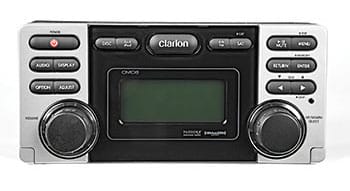
Test Receiver: Clarion CMD8
Our test receiver is water-tight and resistant in a “salt-fog test.” I’ve used an earlier model in seven years of ocean boating. Hitch your iPhone to it and rate your Pandora tunes to refine your list. Play MP3s or CDs. Accessorize with Wi-Fi or wired remotes. $399
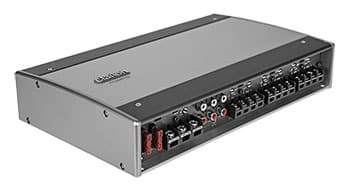
Test Amp: Clarion XC6610 Amp
Our 1,000-watt amp was hot off the line and easy to adjust for boost, decibels and gain. Removable trim allows access to mounting hardware. Circuitry is coated and connectors are corrosion resistant. Ideal for flat mounting. $649
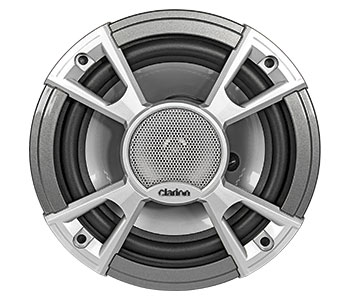
Speaker
Clarion CMQ1622R 6.5″ 2-Way
$229.95; Clarion.com
On the Water: 5
In the Lab: 20
Stylish but rugged, they are water and saltwater corrosion resistant. Woofer cone is 6½ inches, made of mica-injected polypropylene with a 1¼-inch compression horn tweeter. The one-piece speaker cage and flange is of cast aluminum.
Downside: Speaker mounting screws pass through plastic speaker grille holes, weakening installation.
Frequency Response Graph: Clarion and Jensen were the toughest competitors in the lab and on the water.
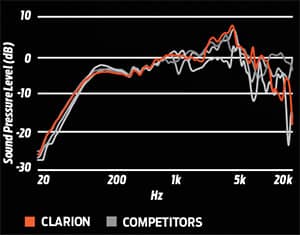
Lab Test Results
Frequency response to 10 kHz: ±6.2 dB
Frequency response to 20 kHz: ±11.7 dB
Bass extension (-3 dB): 54 Hz
Average impedance: 4?
Sensitivity: 91.8 dB
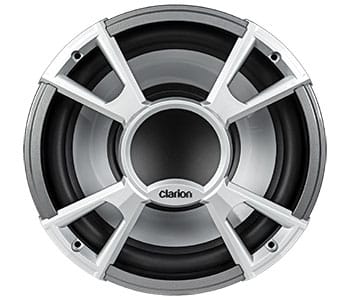
Subwoofer
Clarion CMQ2512W
$259.95; Clarion.com
On the Water: 4
In the Lab: 12
Identical to the speaker set in appearance, the waterproof woofer is at home in a wet and salty world. It too has a sturdy cast aluminum cage and flange, and the cone is mica-injected polypropelene for added strength and response.
Downside: Our prototype had only four mounting holes. The production model will have eight.
Frequency Response Graph: Subwoofers ran a nearly concurrent curve on the graph, explaining our difficulty in distinguishing them.
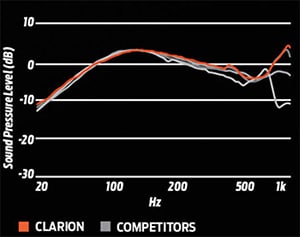
Lab Test Results
CEA-2010A average bass output 40-63 Hz: 120.0 db
CEA-2010A average bass output 20-31.5 Hz: 103.3 db
Bass extension (-3 dB): 41 Hz
Average impedance: 6?
Sensitivity: 89.5 db
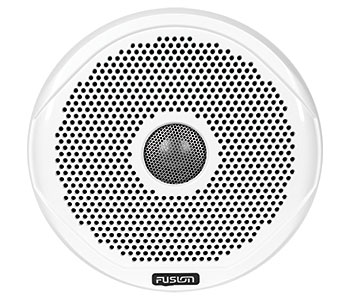
Speaker
Fusion MS FR7021 2-Way
$199.99; fusionelectronics.com
On the Water: 3
In the Lab: 13
Fusion partners with top navigation electronics makers to integrate its systems with chart plotters — a big plus for easy operation. The systems conform to ASTM D4329 for UV resistance and ASTM B117 for water, salt-fog and dust resistance.
Downside: We expected a bolder sound based on past experience with the brand.
Frequency Response Graph: Crisp, strong base and treble notes were still slightly subdued compared with Jensen.
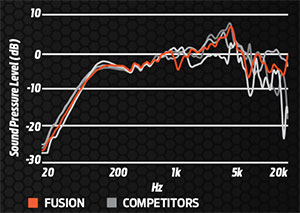
Lab Test Results
Frequency response to 10 kHz: ±7.5 dB
Frequency response to 20 kHz: ±7.5 dB
Bass extension (-3 dB): 62 Hz
Average impedance: 4?
Sensitivity: 89.9 dB
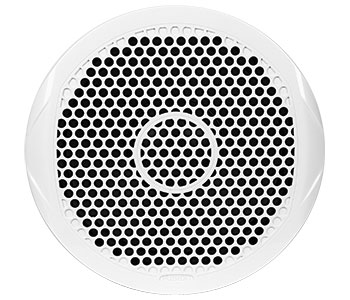
Subwoofer
Fusion MS SW10
$239.99; fusionelectronics.com
On the Water: 4
In the Lab: 12
Subwoofers are there to do one thing: make a thump in your chest when powerful bass notes are struck — this one does it beautifully, though it was slightly edged out in sound by the Clarion.
Downside: Clarion and Jensen sported threaded terminal clamps, which we preferred to Fusion’s screw-over ring connectors.
Frequency Response Graph: Fusion’s thump topped the graph until the most extreme sounds — a pattern we detected on the water.
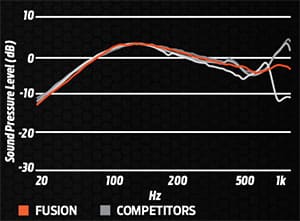
Lab Test Results
CEA-2010A average bass output 40-63 Hz: 118.4 dB
CEA-2010A average bass output 20-31.5 Hz: 101.5 dB
Bass extension (-3 dB): 43 Hz
Average impedance: 8?
Sensitivity: 87.9 dB
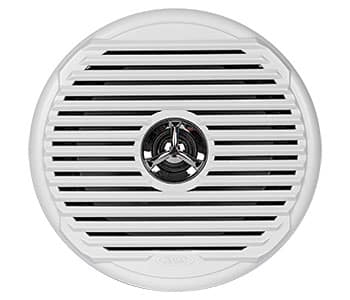
Speaker
Jensen MSX65R 6.5″
$98.99; jensenmarinedirect.com
On the Water: 5
In the Lab: 17
Jensen was recently acquired by ASA Electronics, which has made a strong move to revitalize the brand. These speakers stood tall against the dominant Clarion and sold at a value price. ASTM D4329/UV; ASTM B117 salt-fog certified
Downside: It’s tough to knock a speaker that truly impressed us with sound, but the grilles were a little bland looking.
Frequency Response Graph: Jensen was a tough competitor on the water and in the lab, as the graph shows.
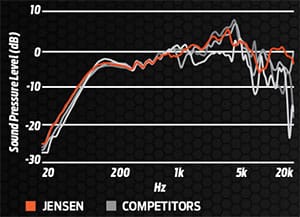
Lab Test Results
Frequency response to 10 kHz: ±6.3 dB
Frequency response to 20 kHz: ±6.3 dB
Bass extension (-3 dB): 56 Hz
Average impedance: 4?
Sensitivity: 90.6 dB
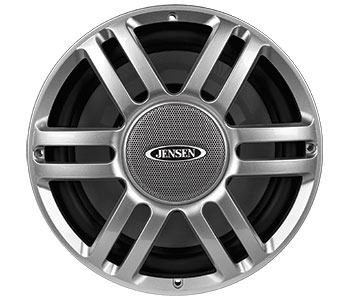
Subwoofer
Jensen MSW10S
$120.95; jensenmarinedirect.com
On the Water: 4
In the Lab: 14
For my middle-age taste this mellow but powerful subwoofer was right on the money, but for my teenage blind tester, she got what she wanted more frequently from the Clarion subwoofer. ASTM-D4329/UV; ASTM B117 salt-fog certified
Downside: I’m nitpicking here, but I don’t like to see screw heads through the grilles.
Frequency Response Graph: Jensen was barely edged out by Clarion in the frequency response test.
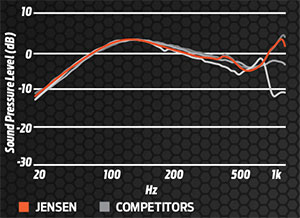
Lab Test Results
CEA-2010A average bass output 40-63 Hz: 119.6 dB
CEA-2010A average bass output 20-31.5 Hz: 102.3 dB
Bass extension (-3 dB): 41 Hz
Average impedance: 8?
Sensitivity: 87.7 dB
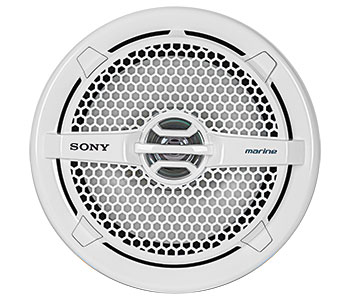
Speaker
Sony XSMP1611 Bi-axial
$69.95; sony.com
On the Water: 1
In the Lab: 7
It’s hardly fair to compare a bargain-priced speaker set in this arena — you’d expect these results — but this is one of the most popular brands, and we noticed this: If played alone, the amp gain boosted, it’s going to sound good to you. It did to us when later played alone. Waterproof IPX-5; ASTM G154/UV; salt/ASTM B11
Downside: We would love to have color choices for the grille.
Frequency Response Graph: Value-priced speakers are usually more sensitive to gain to give better sound without an amplifier in the system.
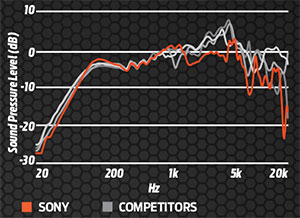
Lab Test Results
Frequency response to 10 kHz: ±8.1 dB
Frequency response to 20 kHz: ±14.5 dB
Bass extension (-3 dB): 67 Hz
Average impedance: 5?
Sensitivity: 88.6 dB
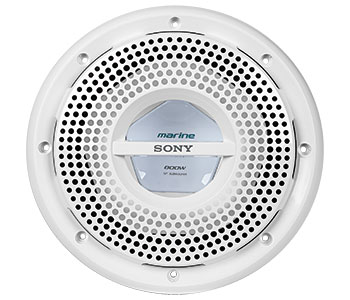
Subwoofer
Sony XSL100P5M
$99.95; sony.com
On the Water: 3
In the Lab: 13
Its polypropylene cone looks and feels bulletproof. Boosting the gain would likely have brought out a bigger thump, but our goal was to test response at a given setting. Eight screw holes go through the grille, but Sony includes beauty buttons to hide them for a nice, easy installation. Waterproof IPX-5; ASTM G154/UV; salt/ASTM B11
Downside: Spade connectors seem lightweight for marine use.
Frequency Response Graph: The Sony showed some strong characteristics in the lab but fell off at the curve’s end.
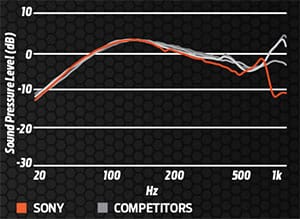
Lab Test Results
CEA-2010A average bass output 40-63 Hz: 119.6 dB
CEA-2010A average bass output 20-31.5 Hz: 102.4 dB
Bass extension (-3 dB): 40 Hz
Average impedance: 10?
Sensitivity: 84.7 dB
For more marine audio reviews and installation tips:
Rockin’ and Rollin’
Stereo Installation Tips
Seagoing Stereo Systems
Jensen JMS7010
Marine Audio Reviews
What You Don’t Need to Know
Frequency response (±X.X dB)
This most important speaker spec reveals how natural the speaker sounds. For flush-mount marine speakers, something in the ±6 decibels (dB) range is pretty good. If the manufacturer specifies only a frequency range without a plus/minus dB figure, the rating isn’t very useful.
Sensitivity (SPL @ 1 watt/1 meter)
This tells how much sound pressure you’ll get from a speaker with 1 watt of power. Every additional +3 dB of sound requires double the power, i.e., a speaker rated at 88 dB/1 watt requires 2 watts for 91 dB, 4 watts for 94 dB, 16 watts for 100 dB, and so on. Most people consider 100 dB quite loud.
Impedance
This tells how much load the speaker puts on the amp, and also how much power you’ll be able to pull from it. The lower the number, the more power you’ll get from your amp — but if you go too low, you’ll tax the amp too much. Marine speakers should be in the 4-ohm range.
Resonant Frequency/Bass Extension
There are technical differences between these two ratings, but they’ll give you a general idea of the lowest frequency you’ll get from the speaker. The lower the number, the deeper the bass you’ll get. With flush-mount speakers, the size of the space behind the speaker will have a big effect on bass extension. Generally, the bigger the space behind the speaker, the deeper the bass you’ll get.
Recommended RMS Power
Ignore this number. It’s rarely the result of technical evaluation. Usually it’s just a mix of the engineer’s gut feel and the marketing guy’s need to show a certain spec. Paradoxically, sometimes a less-powerful amp is more dangerous to your speaker because the less-powerful amp will probably distort more, and distortion tends to damage speakers.
Maximum Power
Another number you can largely ignore. While there are legit ways to test this, it usually has more to do with marketing than anything else. (Notice it’s almost always a nice, round number?) It would be great to know if a speaker can tolerate blasting at 105 dB for hours, but a vague maximum power spec will never tell you that.
Installation Notes
There is more to a good speaker system than the way it sounds, and we also took note of ease of installation, included hardware and templates.
Clarion CMD8 Play Head
This stereo head’s cutting template was the best we experienced. It was a clear sticker that adhered to the panel, giving crisp cutting lines and drill points. As good as that was, “driving” a jigsaw from drilled corner hole to corner hole isn’t as easy as it looks, and we had to do a little filing and grinding to get the fit perfect.
Clarion XC6610 Amplifier
The compact footprint of this amp was welcome in the GT 150, but it was designed for a flat mount. Not so lucky in this boat, but the factory reps said it would still cool adequately in a vertical orientation. Trim panels attached with Allen screws give access to the mounting-screw holes and¬ then can be replaced for a handsome, sleek look.
Clarion Subwoofer
“Why pre-drill only four holes on the mounting flange?” we asked ourselves. The screws go through the grille and speaker to fasten it to the mounting surface. We think Clarion should have drilled four more holes through the subwoofer’s aluminum flange to mount the speaker and then used the four screws through the grille and flange.
Fusion Speakers
In both the speakers and subwoofers, the grilles used a twist-lock mechanism after the speaker was screwed in place. Very handy.
Jensen Speakers
They included both white and silver grilles.
Sony Speakers
Screw caps were included with the speaker grilles to cover the screw heads and beautify the installation.
Cutting Templates
Sony’s speaker templates were perforated into the box, giving the best stencil guide. Cutting paper templates, then tracing, and then cutting leaves too much room for error.
Subwoofer Connections
Only Fusion used spade connectors on the subwoofers. Jensen, Clarion and Sony use screw-clamp fixtures for a more positive connection.






